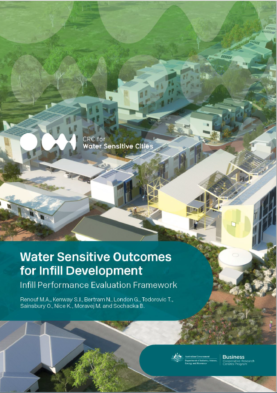Water sensitive outcomes for infill development: Infill performance evaluation framework
Executive Summary
Most major Australian (and many global) cities expect intensified infill development over the coming decades. Infill development is promoted nationwide as a way of accommodating growing urban populations by increasing urban densities (densification) rather than allowing urban sprawl. Currently, the bulk of infill development occurring in Australian capital cities involves subdivisions of single suburban lots into denser single- and multi-unit dwellings, and apartment buildings around transport nodes. This pattern achieves higher density targets but increases building footprint and thus imperviousness of the redeveloped lot, most often at the expense of usable greenspace.
Without significant intervention, 'business as usual' redevelopment will have a considerable negative influence on urban hydrology, resource efficiency, urban heat, liveability and amenity. The water sensitive city approach aims to resolve these challenges. This document is prepared as a component of Integrated Research Project 4 (IRP4): Water Sensitive Outcomes for Infill Developments. It sets out the Infill Performance Evaluation Framework, which is intended to help guide the assessment and design of water sensitive cities. Specifically the Framework assesses the performance of an ‘urban entity’ defined as the components within a three-dimensional physically bounded system including all flows and storage of piped and natural water flows.
